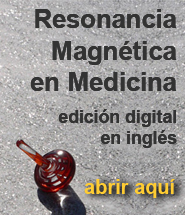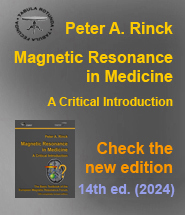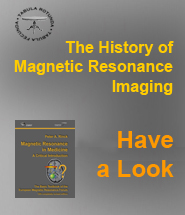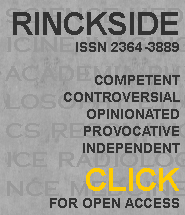Glosario
| a | b | c | d | e | f | g | h | i | j | k | l | m | n | o | p | q | r | s | t | u | v | w | x | y | z |
C
Carr-Purcell (CP) sequence: sequence consisting of a 90° RF pulse followed by a train of repeated 180° RF pulses to produce a train of spin echoes; useful for measuring T2.
Carr-Purcell-Meiboom-Gill (CPMG) sequence: modification of Carr-Purcell RF pulse sequence with 90° phase shift in the rotating frame of reference between the 90° pulse and the subsequent 180° pulses to reduce accumulating effects of imperfections in the 180° pulses. Suppression of effects of pulse error accumulation can alternatively be achieved by alternating phases of the 180° pulses by 180°.
CE FAST → CE FLASH
CE FLASH (Contrast Enhanced FLASH): a fast T2-weighted imaging sequence utilizing refocused transverse coherences.
Chemical shift (δ; see Greek Symbols): the change in the Larmor frequency of a given nucleus when bound in different sites in a molecule, due to the magnetic shielding effects of the orbiting electrons. Chemical shifts make possible the differentiation of different molecular compounds and different sites within the molecules in high resolution NMR spectra. The amount of the shift is proportional to magnetic field strength and is usually specified in parts per million (ppm) of the resonance frequency relative to a standard.
Chemical shift imaging: a method in which spatial location is phase encoded and a spectrum is recorded at each phase encoding step allowing spectra to be acquired in a number of volumes which cover the whole sample.
Cine-MRI: method to show dynamic processes, such as the ejection of blood out of the heart into the aorta, by means of fast imaging and displaying the resulting images in a sequential loop.
Coherence: maintenance of a constant phase relationship between rotating or oscillating waves or objects. Loss of phase coherence of the spins results in a decrease in the transverse magnetization and hence a decrease in the NMR signal.
Coil: single or multiple loops of wire (or other electrical conductor, such as tubing, etc.) designed either to produce a magnetic field from current flowing through the wire, or to detect a changing magnetic field by voltage induced in the wire.
Computer: as used for NMR, can be divided into central processing unit (CPU), consisting of instruction, interpretation and arithmetic unit plus fast access memory, and peripheral devices such as bulk data storage and input and output devices (including, via the interface, the spectrometer). Under software control, the computer controls the RF pulses and gradients necessary to acquire data, and process the data to produce spectra or images. (Note that devices such as the spectrometer may themselves incorporate small computers.)
Continuous wave NMR (CW-NMR): the original technique for studying NMR in which RF radiation is applied continuously to the sample, and either the RF frequency or the magnetic field is slowly swept through the resonance values; now superseded by pulse NMR techniques.
Contrast: contrast can be defined as the relative difference of the signal intensities in two adjacent regions. If the two intensities are Ia and Ib, a useful quantitative definition of contrast is (Ia-Ib) / (Ia+Ib). Relating image contrast to object contrast is more difficult in magnetic resonance imaging than in conventional radiography, as there are more object parameters affecting the image and their relative contributions are very dependent on the particular imaging technique used.
Contrast agents: Chemical agents influencing the contrast behavior of magnetic resonance images and spectra. Commonly used agents include paramagnetic and superparamagnetic media. Contrary to x-ray contrast agents which are directly visible, magnetic resonance imaging contrast agents influence the behavior of the surrounding tissue; thus they are indirect contrast agents.
CP → Carr-Purcell.
CPMG → Carr-Purcell-Meiboom-Gill.
CPU → Computer.
CSI → Chemical shift imaging.
Crossed-coil: coil pair arranged with their magnetic fields at right angles to each other in such a way as to minimize their mutual electromagnetic interaction.
Cryomagnet → Superconducting magnet.
Cryostat: an apparatus for maintaining a constant low temperature (as by means of liquid helium). Requires vacuum chambers to help with thermal isolation → Dewar.
CW: → Continuous wave.
Missing terms? Send us an e-mail. We'll add them ...












